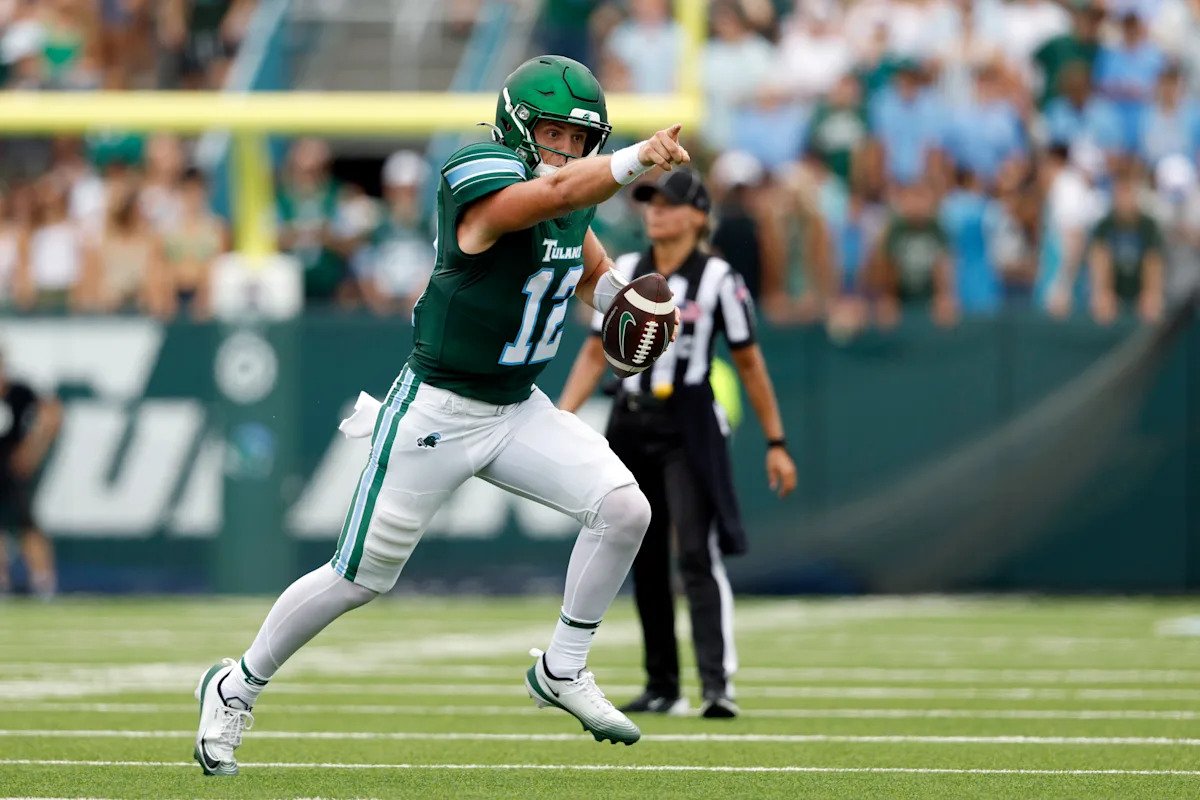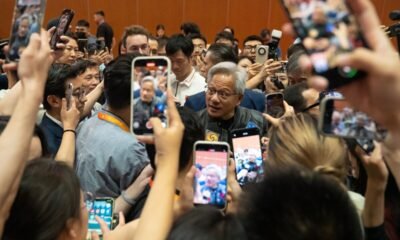Top Stories
Nvidia Earnings Recap: Stock Falls As China Sales Uncertain

Nvidia’s earnings report is here — but clarity on its future chip sales in China isn’t.
Nvidia reported fiscal second-quarter earnings on Wednesday after the closing bell, revealing it beat revenue and earnings forecasts for the period, with sales of $46.74 billion and EPS of $1.05.
Its third-quarter forecast was less rosy, as it didn’t factor in any H20 chip sales in China, an important market for the company.
Nvidia’s chief financial officer, Colette Kress, said that the company is awaiting a formal regulation on the 15% remittance that the White House wants Nvidia and AMD to pay from chips sold to China as a condition to allow it to continue sales in the region.
Nvidia is ready to ship between $2 to $5 billion in H20 chips, the CFO added.
“We’re still waiting on several of the geopolitical issues going back and forth between the governments and the companies trying to determine their purchases and what they want to do,” she said.
Nvidia provided a revenue range for the current quarter of $52.9 billion to $55.1 billion, compared to expectations of $53.46 billion. While the revenue forecast may seem in line, some analysts had put the figure closer to $60 billion.
Nvidia said it didn’t sell any H20 chips to China during the second quarter, although some inventory was sold to a customer outside of the country.
“We just have to keep advocating,” Huang says of the company’s efforts to convince the Trump administration to let it do business in China.
“It is the second-largest computing market in the world, and it is also the home of AI researchers. About 50% of the world’s AI researchers are in China,” he said. “So it’s fairly important, I think, for the American technology companies to be able to address that market.”
Huang said demand for Nvidia’s AI chips continues to be strong.
“Everything’s sold out,” he said.
Nvidia’s stock slid 3% in volatile after-hours trading shortly after the results. The stock’s year-to-date gain was 35% at market close.
Huang and Kress answered analysts’ questions during a follow-up earnings call — scroll on for the play-by-play.
Top Stories
Tulane coach says Northwestern denied team’s request to wear white jerseys to honor ’05 team displaced by Hurricane Katrina

Tulane coach Jon Sumrall said that Northwestern denied his team’s request to wear white jerseys on Saturday to honor the 2005 Green Wave team.
Friday was the 20th anniversary of Hurricane Katrina’s landfall in the city of New Orleans. The hurricane is one of the worst natural disasters in United States history; a majority of New Orleans was flooded and over 1,000 people died as the city dealt with long-term effects from the storm.
Advertisement
[Join or create a Yahoo Fantasy Football league for the 2025 NFL season]
The damage from Katrina forced Tulane to cancel the entire fall semester and the 2005 team ended up playing all 12 of its games on the road because of the damage to the Louisiana Superdome. As stadiums across the state of Louisiana and the surrounding areas were booked for football games, Tulane’s home games ended up being played at six different stadiums.
Tulane players didn’t have the Green Wave logo decals on their helmets on Saturday, like the 2005 team did in its first game of the season against Mississippi State. And after the team’s 23-3 win over Northwestern on Saturday, Sumrall said the team wanted to go further and wear their white road jerseys, but Northwestern didn’t agree to the idea.
Northwestern wore its white road jerseys for the game while Tulane wore its traditional green home uniforms. Per NCAA rules, the road team cannot dictate which color jersey a home team wears.
Advertisement
Tulane scored 20 points in the first half as Northwestern QB Preston Stone threw four interceptions and averaged fewer than 5 yards a pass attempt. Meanwhile, Tulane QB Jake Retzlaff had two total touchdowns and threw for 152 yards and rushed for 113 more on 10 carries in his first game with the Green Wave.
Saturday was Retzlaff’s first game with Tulane. He arrived on campus over the summer after he transferred from BYU. Retzlaff, the Cougars’ starting QB in 2024, left BYU after a woman filed a civil lawsuit against him accusing him of sexual assault in the fall of 2023.
Retzlaff denied the allegations and the suit was eventually dismissed. However, he admitted to having sex with the woman and, as a result, was facing a seven-game suspension from BYU for an honor code violation. Instead of missing over half the 2025 season, Retzlaff opted to find a new school.
Top Stories
Robin Westman displayed signs of self-harm at prep school, former teacher said

An art teacher who had the Annunciation Catholic Church shooter in her class in 2017 said she saw signs of self-harm on her then-student.
The teacher, Sarah Reely, said Robin Westman was in her class for a year at an all-boys prep school in Minnesota, where she noticed evidence of self-harm on the student’s arm and reported it.
“Self harm is either a cry for help, an indication of self hate, or both. But it’s always sign something is wrong,” Reely wrote in a Facebook post on Thursday.
Westman, 23, opened fire at Annunciation Catholic Church in Minneapolis during morning Mass on Wednesday, killing two children and injuring 18 other worshippers.
Reely said in her post that she saw a photo of Westman, a transgender woman, and immediately recognized her. The teacher said she knew at the time Westman was “a kid who needed help.”
“She was definitely odd, was really into furries and odd artwork and said some odd things, but wasn’t violent towards others to my knowledge,” Reely wrote. “Being odd isn’t a red flag — I was an odd kid myself and have always had a heart for the odd kids.”
Reely said Westman did not fit in at the school, “as one might imagine would happen to a queer kid in a conservative environment,” and that she “intentionally made a point to build a relationship,” with her.
Westman eventually transferred schools, Reely said, but she always hoped that her former student was OK.
“I am NOT posting this to build sympathy for a murderer or place blame on any one person or entity for failing to stop this,” Reely wrote. “I am posting this to remind people that it’s a snowball effect of multiple system failures at a national level, that every murderer was once a kid in someones classroom who needed help, and that this issue is so much deeper and more complicated than we want to admit.”
Reely declined to speak to NBC News about Westman.
On Wednesday, Westman fired a rifle through the side windows of Annunciation Catholic School’s church, aiming at children sitting in the pews, just before 8:30 a.m.
Westman was a student at Annunciation, and her mother, Mary Grace Westman, had once worked at the school.
The shooter was found dead at the rear of the church with an apparent self-inflicted gunshot wound to the head, according to search warrants. She was found dressed in black “tactical” gear with at least two firearms nearby, police said.
Officials found approximately 120 shell casings from three different guns the shooter used, according to Minneapolis Police Chief Brian O’Hara. O’Hara said Westman had a “fascination” with mass shootings, and acting U.S. Attorney for Minnesota Joseph Thompson said she “wanted to watch children suffer.”
O’Hara said Thursday that authorities do not have information indicating that Westman suffered from mental illness and that, other than a traffic ticket, she did not have a police record. But a heavily redacted police report from 2018 shows that police were called to a townhouse where Westman lived with her mother. Mental health was noted as the reason for the call.
Minnesota has a red flag law that went into effect in January 2024, allowing family members and others to petition the courts to have guns removed from a person they believe poses a threat to themselves or the community. But it does not appear any alarms were sounded as Westman amassed an arsenal that included a rifle, a pistol and a shotgun used in the attack on the church.
The investigation into the shooting is ongoing.
If you or someone you know is in crisis, call or text 988 to reach the Suicide and Crisis Lifeline or chat live at 988lifeline.org. You can also visit SpeakingOfSuicide.com/resources for additional support.
Top Stories
‘Frankenstein’ Gets Monster 15-Minute Ovation — Venice Film Festival

Oscar and Golden Lion winner Guillermo Del Toro unveiled his long-in-the-works Frankenstein at the Venice Film Festival this evening. Playing to a very enthusiastic crowd, the monster movie was greeted by a 15-minute ovation.
Del Toro has charmed the Lido before, winning the festival’s top prize, the Golden Lion, with 2017’s The Shape of Water, which ultimately went on to scoop four Oscars, including Best Picture and Director.
Frankenstein, adapted by Del Toro from the 1818 literary classic by Mary Shelley, is playing here in competition; Netflix will release in November.
In the film, Oscar Isaac stars as Dr. Victor Frankenstein, a brilliant but egotistical scientist who brings a creature (Jacob Elordi) to life in a monstrous experiment that ultimately leads to the undoing of both the creator and his tragic creation.
During a press conference here earlier today, Del Toro said of his inspiration for making the movie: “It was a religion for me. Since I was a kid — I was raised very Catholic — I never quite understood the saints. And then when I saw Boris Karloff on the screen, I understood what a saint or a messiah looked like. So I’ve been following the creature since I was a kid, and I always waited for the movie to be done in the right conditions, both creatively in terms of achieving the scope that it needed for me to make it different, to make it at a scale that you could reconstruct the whole world.”
Frankenstein also stars Mia Goth, Felix Kammerer, Lars Mikkelsen, David Bradley, Christian Convery, Charles Dance and Christoph Waltz.
Del Toro produced alongside longtime collaborator J. Miles Dale and Scott Stuber.
-
Tools & Platforms3 weeks ago
Building Trust in Military AI Starts with Opening the Black Box – War on the Rocks
-

 Ethics & Policy1 month ago
Ethics & Policy1 month agoSDAIA Supports Saudi Arabia’s Leadership in Shaping Global AI Ethics, Policy, and Research – وكالة الأنباء السعودية
-

 Events & Conferences3 months ago
Events & Conferences3 months agoJourney to 1000 models: Scaling Instagram’s recommendation system
-

 Jobs & Careers2 months ago
Jobs & Careers2 months agoMumbai-based Perplexity Alternative Has 60k+ Users Without Funding
-

 Funding & Business2 months ago
Funding & Business2 months agoKayak and Expedia race to build AI travel agents that turn social posts into itineraries
-

 Education2 months ago
Education2 months agoVEX Robotics launches AI-powered classroom robotics system
-

 Business1 day ago
Business1 day agoThe Guardian view on Trump and the Fed: independence is no substitute for accountability | Editorial
-

 Podcasts & Talks2 months ago
Podcasts & Talks2 months agoHappy 4th of July! 🎆 Made with Veo 3 in Gemini
-

 Podcasts & Talks2 months ago
Podcasts & Talks2 months agoOpenAI 🤝 @teamganassi
-

 Mergers & Acquisitions2 months ago
Mergers & Acquisitions2 months agoDonald Trump suggests US government review subsidies to Elon Musk’s companies





















